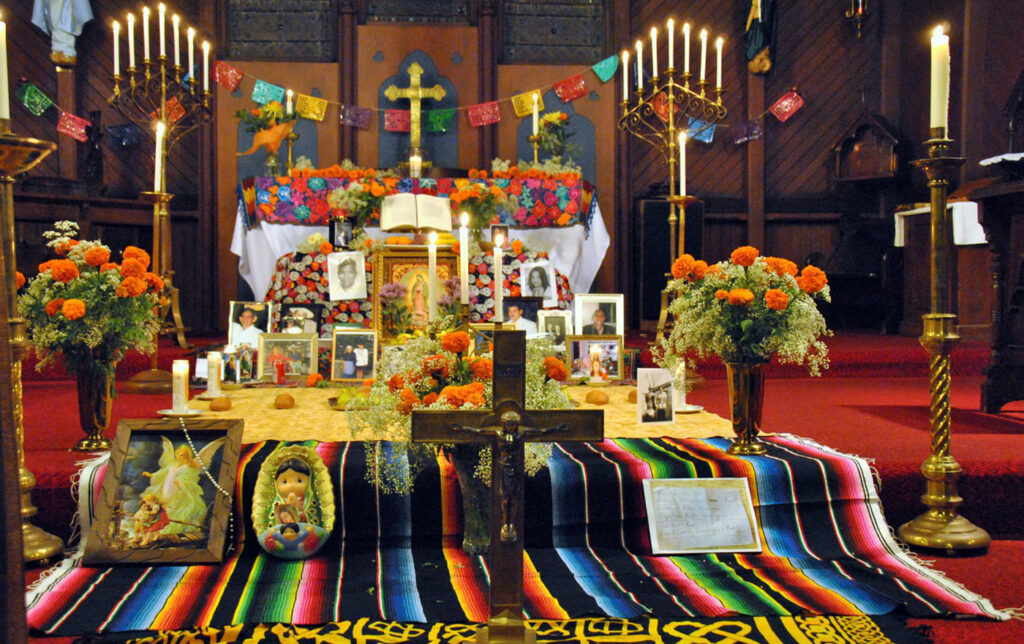
Origins
The original iteration of Día de los Muertos was an Aztec festival first mentioned approximately 3000 years ago, prior to Spanish colonization in the 1600s. This version took place at the beginning of August and lasted for an entire month! The festival was dedicated to the goddess Mictēcacihuātl, or “Lady of the Dead,” who ruled over the afterlife. However, when the Spanish came, Christian traditions fused with indigenous traditions. By the late 20th century, Día de los Muertos came to be associated with Allhallowtide, or the three day celebration consisting of All Saints’ Eve, All Saints’ Day, and All Souls’ Day. This celebration occurs from October 31 to November 2.
Though Día de los Muertos is mainly celebrated on November 2nd, it is actually a two day celebration. The first day, known as Día de los Inocentes, or Day of the Innocents, is on November 1st, when the souls of children return to visit their loved ones. The souls of adults return on November 2nd and this day is known as the titular Día de los Muertos, or Day of the Dead.
Celebration
Día de los Muertos is chiefly a day of remembrance and a celebration of the life of the deceased. Generally, an altar, or ofrenda, is made either in a home or graveyard. This is not an altar at which one worships, but rather one that is intended to welcome the soul of the deceased to visit. The flower most used on an ofrenda is the Mexican marigold called cempasúchil. The bright petals and strong scent are said to attract the soul of the deceased to the ofrenda. Another common sight on an ofrenda are sugar skulls and pan de muerto (bread of the dead), which is a sweet flavored bread. Photos, toys, mementos, water, alcohol, and other food items are also common ofrenda items.
In addition to an ofrenda, the family and loved ones go to the resting place of the deceased and clean the area where the loved one is buried. Families gathered around an ofrenda often pray or reflect upon the life of the deceased.
Día de los Muertos is celebrated in many parts of the the world, especially in Central and South America, but local traditions may vary somewhat.
Allhallowtide
The Christian celebration of Allhallowtide is also a time to remember the dead, including martyrs, saints, and deceased loved ones. Originally martyrs were celebrated on specific days, but soon there were more martyrs than days in the year. In approximately 610 AD All Saints’ Day was established to commemorate all the saints. The festival was held on the first of May. In approximately 800 AD it was moved to November 1st and extended to include All Souls Day.
The first day of Allhallowtide is All Hallows’ Eve, or Halloween. Many scholars believe this day was chosen to coincide with the Celtic celebration of Samhain, which marked the beginning of winter and was also a time when the souls of the dead could visit the living. On Samhain, offerings of food and drink were left outside for the spirits of the dead and feasts were held in their honor. This liminality was retained in the traditions of All Hallows’ Eve and after the vigil of All Hallows’ Eve, festivities and feasting were common.
All Saints’ Day is a principal feast day and is a day to honor all the saints and martyrs, both known and unknown. On All Saints’ Day traditionally there was a good deal of food and festivities to be had.
All Souls’ Day is a day to honor all the dead. Individuals often attend mass and visit graves of their loved ones. Today, All Saints’ and All Souls’ days are often merged or celebrated as the same thing.
Commonality
Día de Los Muertos, though once an Aztec festival, fused with Christian tradition, which had already likely fused with Celtic tradition. Yet no matter what culture, it seems like remembering the dead is important to people. Whether celebrated as Día de los Muertos, Allhallowtide, or another festival, we have more commonalities than differences. Because after all, no matter how we go about doing it, we honor our loved ones by recognizing and celebrating their lives.
Written by Gabe Avila, October 2019
Reprinted with permission from: https://churchofstmartin.org/2019/10/15/what-is-dia-de-los-muertos-and-how-does-it-relate-to-all-saints-day/

